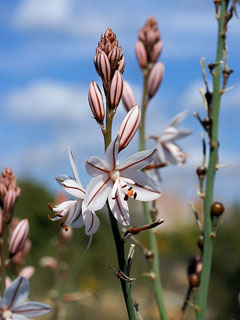 |
|
http://commons.wikimedia.org/wiki/File:Onionweed.jpg |
 |
| http://commons.wikimedia.org/wiki/User:Lycaon |
Translate this page:
Summary
Physical Characteristics

 asphodelus fistulosus is a ANNUAL/PERENNIAL growing to 0.6 m (2ft).
asphodelus fistulosus is a ANNUAL/PERENNIAL growing to 0.6 m (2ft).
See above for USDA hardiness. It is hardy to UK zone 8 and is not frost tender. It is in flower from July to August. The species is hermaphrodite (has both male and female organs) and is pollinated by Insects.
Suitable for: light (sandy) and medium (loamy) soils, prefers well-drained soil and can grow in nutritionally poor soil. Suitable pH: mildly acid, neutral and basic (mildly alkaline) soils. It can grow in semi-shade (light woodland) or no shade. It prefers dry or moist soil.
UK Hardiness Map
US Hardiness Map
Synonyms
A. tenuifolius. Cav.
Plant Habitats
Cultivated Beds;
Edible Uses
Edible Parts: Leaves Root
Edible Uses:
Root - cooked.[46, 61, 105] The root is fibrous according to one report[100] whilst another says that the swollen root has radical root fibres[42]. The plant is eaten as a vegetable, records of 'edible bulbs' seem to be erroneous[177].
References More on Edible Uses
Medicinal Uses
Plants For A Future can not take any responsibility for any adverse effects from the use of plants. Always seek advice from a professional before using a plant medicinally.
Diuretic Skin
The seed is diuretic[240]. It is also applied externally to ulcers and inflamed parts of the body[240]. The seed contains oils rich in linoleic acid and are of value in preventing atherosclerosis[240].
References More on Medicinal Uses
The Bookshop: Edible Plant Books
Our Latest books on Perennial Plants For Food Forests and Permaculture Gardens in paperback or digital formats.

Edible Tropical Plants
Food Forest Plants for Hotter Conditions: 250+ Plants For Tropical Food Forests & Permaculture Gardens.
More

Edible Temperate Plants
Plants for Your Food Forest: 500 Plants for Temperate Food Forests & Permaculture Gardens.
More

More Books
PFAF have eight books available in paperback and digital formats. Browse the shop for more information.
Shop Now
Other Uses
References More on Other Uses
Cultivation details
Succeeds in ordinary garden soil, tolerating partial shade[200]. Requires a well-drained soil. Prefers a deep rich sandy loamy soil[1, 42]. Prefers a sunny position in a soil that is not too rich[200]. Grows well on hot dry banks[42]. This species is often a short-lived perennial[270], though it is not very hardy in Britain. This has contributed to the mistaken belief that it is an annual. A covering of bracken overwinter is usually ample protection in most districts[42]. Asphodelus fistulosus has become a noxious weed in California and in other places with Mediterranean climates worldwide[270]. The flowers are sweetly scented[245]. Plants seem to be immune to the predations of rabbits[233].
References Carbon Farming Information and Carbon Sequestration Information
Temperature Converter
Type a value in the Celsius field to convert the value to Fahrenheit:
Fahrenheit:
The PFAF Bookshop
Plants For A Future have a number of books available in paperback and digital form. Book titles include Edible Plants, Edible Perennials, Edible Trees,Edible Shrubs, Woodland Gardening, and Temperate Food Forest Plants. Our new book is Food Forest Plants For Hotter Conditions (Tropical and Sub-Tropical).
Shop Now
Plant Propagation
Seed - sow March/April in a greenhouse and only just cover the seed. Germination usually takes place in 1 - 3 months at 15°c[134]. When they are large enough to handle, prick the seedlings out into individual pots and grow them on in the greenhouse for at least their first winter. When the plants are large enough to handle, plant them out into their permanent positions in late spring or early summer. Division in early spring or autumn[111].
Other Names
If available other names are mentioned here
Hollow-stemmed asphodel, wild onion, onionweed, onion-leafed asphodel, and pink asphodel.
Native Range
TEMPERATE ASIA: Cyprus, Egypt (Sinai), Israel, Jordan, Lebanon, Syria, Turkey EUROPE: Former Yugoslavia, Greece (incl. Crete), Italy (incl. Sardinia, Sicily), Spain (incl. Baleares), France (incl. Corsica), Portugal AFRICA: Spain (Canarias), Portugal (Madeira Islands), Algeria (north), Morocco, Tunisia (possibly)
Weed Potential
Right plant wrong place. We are currently updating this section.
Please note that a plant may be invasive in one area but may not in your area so it's worth checking.
This plant can be weedy or invasive. An invasive exotic weed in the US, with significant infestations in California, Arizona, New Mexico, and Texas. It is listed as a Federal Noxious Weed by the United States Department of Agriculture. Also a common weed in parts of Australia, New Zealand, and Mexico, and it thrives in any area with a Mediterranean climate.
Conservation Status
IUCN Red List of Threatened Plants Status : Status: Least Concern

Growth: S = slow M = medium F = fast. Soil: L = light (sandy) M = medium H = heavy (clay). pH: A = acid N = neutral B = basic (alkaline). Shade: F = full shade S = semi-shade N = no shade. Moisture: D = dry M = Moist We = wet Wa = water.
Now available:
Food Forest Plants for Mediterranean Conditions
350+ Perennial Plants For Mediterranean and Drier Food Forests and Permaculture Gardens.
[Paperback and eBook]
This is the third in Plants For A Future's series of plant guides for food forests tailored to
specific climate zones. Following volumes on temperate and tropical ecosystems, this book focuses
on species suited to Mediterranean conditions—regions with hot, dry summers and cool, wet winters,
often facing the added challenge of climate change.
Read More
Expert comment
Author
L.
Botanical References
50200
Links / References
For a list of references used on this page please go here
Readers comment